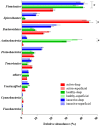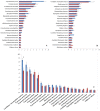Altered microbiomes in bovine digital dermatitis lesions, and the gut as a pathogen reservoir
- PMID: 25781328
- PMCID: PMC4362943
- DOI: 10.1371/journal.pone.0120504
Altered microbiomes in bovine digital dermatitis lesions, and the gut as a pathogen reservoir
Abstract
Bovine digital dermatitis (DD) is the most important infectious disease associated with lameness in cattle worldwide. Since the disease was first described in 1974, a series of Treponema species concurrent with other microbes have been identified in DD lesions, suggesting a polymicrobial etiology. However, the pathogenesis of DD and the source of the causative microbes remain unclear. Here we characterized the microbiomes of healthy skin and skin lesions in dairy cows affected with different stages of DD and investigated the gut microbiome as a potential reservoir for microbes associated with this disease. Discriminant analysis revealed that the microbiomes of healthy skin, active DD lesions (ulcerative and chronic ulcerative) and inactive DD lesions (healing and chronic proliferative) are completely distinct. Treponema denticola, Treponema maltophilum, Treponema medium, Treponema putidum, Treponema phagedenis and Treponema paraluiscuniculi were all found to be present in greater relative abundance in active DD lesions when compared with healthy skin and inactive DD lesions, and these same Treponema species were nearly ubiquitously present in rumen and fecal microbiomes. The relative abundance of Candidatus Amoebophilus asiaticus, a bacterium not previously reported in DD lesions, was increased in both active and inactive lesions when compared with healthy skin. In conclusion, our data support the concept that DD is a polymicrobial disease, with active DD lesions having a markedly distinct microbiome dominated by T. denticola, T. maltophilum, T. medium, T. putidum, T. phagedenis and T. paraluiscuniculi. Furthermore, these Treponema species are nearly ubiquitously found in rumen and fecal microbiomes, suggesting that the gut is an important reservoir of microbes involved in DD pathogenesis. Additionally, the bacterium Candidatus Amoebophilus asiaticus was highly abundant in active and inactive DD lesions.
Conflict of interest statement
Figures












References
-
- Garbarino EJ, Hernandez JA, Shearer JK, Risco CA, Thatcher WW. (2004) Effect of lameness on ovarian activity in postpartum holstein cows. J Dairy Sci 87: 4123–4131. - PubMed
-
- Losinger WC. (2006) Economic impacts of reduced milk production associated with papillomatous digital dermatitis in dairy cows in the USA. J Dairy Res 73: 244–256. - PubMed
Publication types
MeSH terms
Associated data
LinkOut - more resources
Full Text Sources
Other Literature Sources

